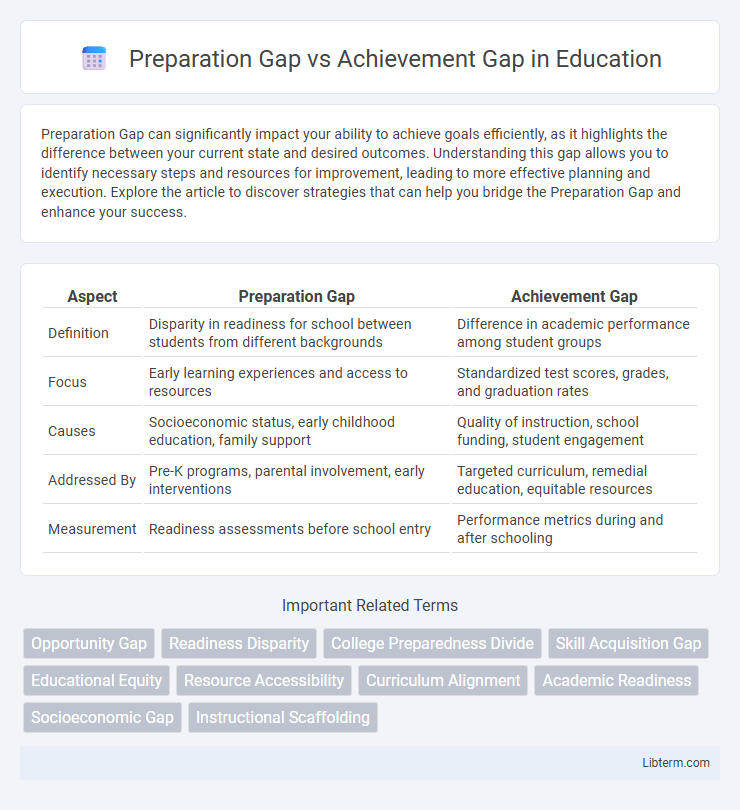Preparation Gap can significantly impact your ability to achieve goals efficiently, as it highlights the difference between your current state and desired outcomes. Understanding this gap allows you to identify necessary steps and resources for improvement, leading to more effective planning and execution. Explore the article to discover strategies that can help you bridge the Preparation Gap and enhance your success.
Table of Comparison
| Aspect | Preparation Gap | Achievement Gap |
|---|---|---|
| Definition | Disparity in readiness for school between students from different backgrounds | Difference in academic performance among student groups |
| Focus | Early learning experiences and access to resources | Standardized test scores, grades, and graduation rates |
| Causes | Socioeconomic status, early childhood education, family support | Quality of instruction, school funding, student engagement |
| Addressed By | Pre-K programs, parental involvement, early interventions | Targeted curriculum, remedial education, equitable resources |
| Measurement | Readiness assessments before school entry | Performance metrics during and after schooling |
Understanding the Preparation Gap
The preparation gap refers to disparities in students' readiness for academic challenges, influenced by factors such as access to quality early childhood education and socio-economic conditions. Understanding the preparation gap involves examining how unequal opportunities in foundational learning environments contribute to varying levels of skills and knowledge before formal schooling begins. Addressing this gap requires targeted interventions that provide equitable resources and support to underprepared students, enabling them to succeed and reduce the achievement gap later in education.
Defining the Achievement Gap
The achievement gap refers to the persistent disparity in academic performance between groups of students, often defined by socioeconomic status, race, or ethnicity. It is measured through standardized test scores, graduation rates, and college enrollment statistics, highlighting inequalities in educational outcomes. Closing this gap requires targeted interventions that address both in-school factors and broader socio-economic influences impacting student success.
Key Differences Between Preparation Gap and Achievement Gap
Preparation gap refers to disparities in students' readiness for academic challenges, influenced by factors such as early childhood education and access to resources. Achievement gap measures the differences in academic performance outcomes among student groups, often reflected in test scores and graduation rates. Key differences include that the preparation gap affects the starting point of a student's learning journey, while the achievement gap highlights unequal educational results after instruction.
Root Causes of the Preparation Gap
The preparation gap stems primarily from unequal access to quality early childhood education, disparities in family resources, and variations in home learning environments. Children from low-income households often face limited exposure to enriching experiences and academic support before formal schooling begins. These foundational inequities in early development directly contribute to the wider achievement gap observed in later educational outcomes.
Factors Contributing to the Achievement Gap
Factors contributing to the achievement gap include disparities in access to quality early childhood education, socioeconomic status, and unequal school resources. Family engagement, teacher effectiveness, and exposure to stressors such as poverty also significantly impact student performance. Addressing these factors requires targeted interventions to provide equitable learning opportunities and support systems.
Impact of Socioeconomic Status on Preparation and Achievement
Socioeconomic status significantly influences both the preparation gap and achievement gap by limiting access to quality educational resources, extracurricular opportunities, and academic support for low-income students. Families with higher socioeconomic status often provide enriching environments that enhance cognitive development and readiness, resulting in better academic performance and standardized test scores. This disparity in preparation intensifies the achievement gap, as students from disadvantaged backgrounds face ongoing challenges in meeting academic benchmarks and pursuing higher education.
Early Childhood Education and School Readiness
The preparation gap in early childhood education refers to disparities in access to quality preschool experiences that equip children with foundational skills necessary for academic success. This gap often contributes to the achievement gap observed later in schooling, where children from disadvantaged backgrounds lag in literacy, numeracy, and social-emotional development compared to peers. Prioritizing equitable school readiness initiatives that enhance cognitive and behavioral skills can reduce long-term educational disparities linked to early developmental inequities.
Addressing Gaps: Strategies for Educators and Policymakers
Addressing the preparation gap requires targeted interventions such as early childhood education programs, equitable access to advanced coursework, and teacher professional development focused on differentiated instruction. Closing the achievement gap involves data-driven strategies including formative assessments, personalized learning plans, and increased investment in under-resourced schools. Policymakers must prioritize funding for community-based support services and implement inclusive policies that promote educational equity across socioeconomic and racial lines.
Measuring Success: Assessment Tools for Gaps
Measuring success in addressing preparation and achievement gaps relies heavily on precise and diverse assessment tools such as standardized tests, formative assessments, and diagnostic evaluations to identify specific areas where students lag. Data from tools like the National Assessment of Educational Progress (NAEP) and Progress Monitoring assessments provide critical insights into disparities in academic readiness and performance among different student groups. Effective use of these assessments enables educators to tailor interventions that target the root causes of gaps, thereby promoting equity and enhancing overall educational outcomes.
Bridging the Preparation and Achievement Gaps
Bridging the preparation gap and achievement gap requires targeted interventions addressing disparities in early education access, quality instruction, and resource availability. Closing the preparation gap involves enhancing foundational skills through high-quality preschool programs and equitable funding for schools serving disadvantaged communities. Reducing the achievement gap depends on sustained support such as personalized learning, tutoring, and family engagement to ensure all students reach grade-level proficiency and academic success.
Preparation Gap Infographic

 libterm.com
libterm.com